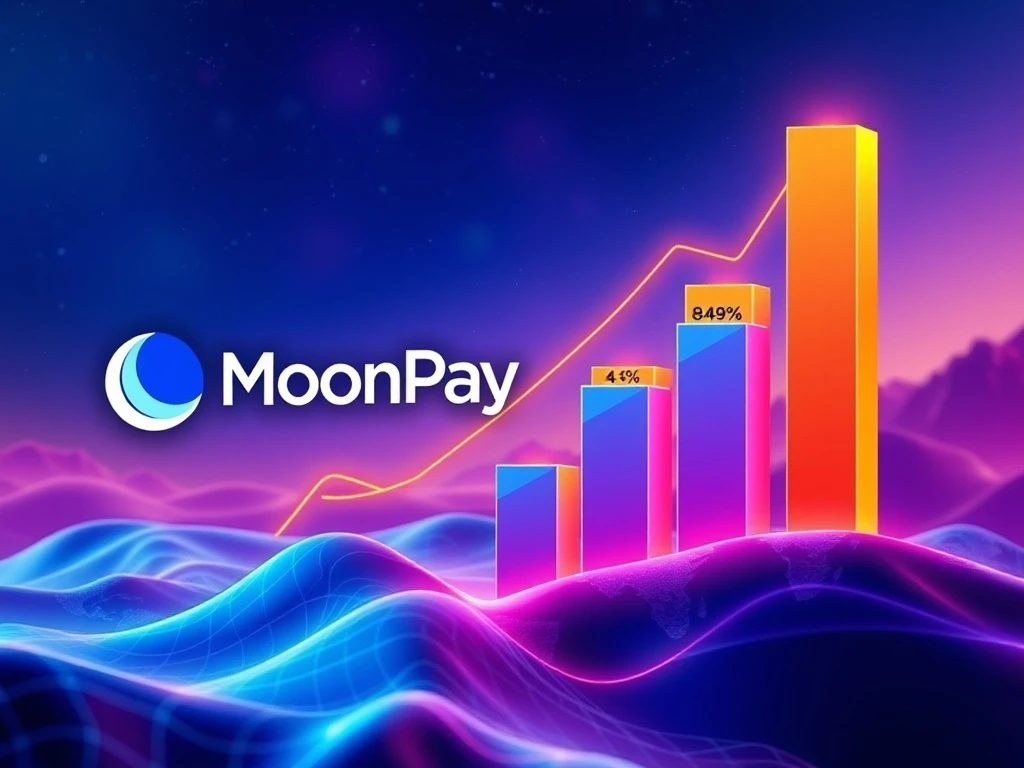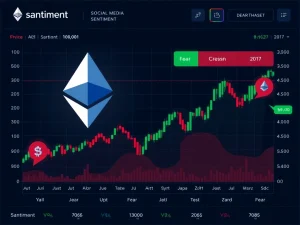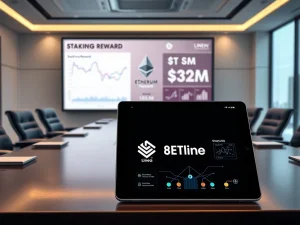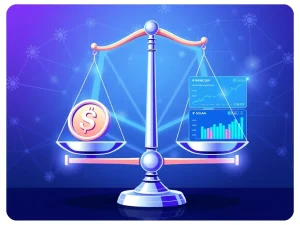Revolutionary Solana Staking: MoonPay Unleashes 8.49% APY, Outperforming Ethereum

Are you looking for an exciting way to maximize your crypto earnings? The world of decentralized finance (DeFi) is constantly evolving, and a recent announcement from MoonPay is set to turn heads, especially for those keen on Solana staking. Imagine earning a significant yield on your digital assets while retaining full control and flexibility. MoonPay has just made this a compelling reality, launching a new liquid staking service for Solana (SOL) that promises an impressive 8.49% annual percentage yield (APY).
Unveiling MoonPay’s Game-Changing Solana Staking Service
MoonPay, a leading crypto payment infrastructure provider, has officially rolled out its innovative Solana staking service directly within its app. This isn’t just another staking option; it’s a streamlined, user-friendly gateway to passive income for SOL holders. With an enticing APY of up to 8.49%, rewards are distributed every two days, ensuring a consistent flow of earnings for participants.
What makes this offering particularly appealing? It’s the accessibility. The service is now live in over 100 countries, including major markets like the U.S. (excluding New York), Canada, and the UK. Even better, you can start staking with as little as $1 worth of SOL. This low barrier to entry democratizes access to crypto yields, allowing a broader audience to participate in the Solana ecosystem’s growth.
MoonPay’s entry into the staking arena positions it as a significant player, joining established platforms like Marinade and Jito, which also offer liquid staking options through tokens such as mSOL and JitoSOL. The emphasis here is on simplicity – no need to run complex validator nodes or navigate intricate protocols. It’s designed to mirror the ease and familiarity of a traditional savings account, but with the amplified earning potential that only blockchain networks can offer.
Why Liquid Staking is a Game Changer for Your Crypto APY
The core innovation behind MoonPay’s new service is liquid staking. Unlike traditional staking, where your assets are locked up and inaccessible, liquid staking provides you with a tokenized representation of your staked assets. In MoonPay’s case, this is mpSOL. This means you can earn staking rewards while still being able to use your assets in other decentralized finance (DeFi) applications, providing unparalleled flexibility.
Here’s why liquid staking is becoming the preferred choice for savvy investors:
- Maintained Liquidity: Your funds aren’t locked away. You receive mpSOL, which can be traded, lent, or used in other DeFi protocols, giving you continuous access to your capital.
- Passive Income: Earn a competitive crypto APY without active management or technical expertise.
- Diversification: Participate in staking rewards while still engaging with the broader DeFi ecosystem.
- Simplicity: MoonPay abstracts away the complexities of running a validator, making it accessible to everyday users.
One of the most compelling aspects of MoonPay’s offering is its superior yield. The 8.49% APY on Solana significantly surpasses the typical 4-5% average yields seen in Ethereum-based staking options. This makes it an incredibly attractive proposition for retail investors looking for higher returns on their staked assets.
| Feature | MoonPay Solana Staking | Typical Ethereum Staking |
|---|---|---|
| APY | Up to 8.49% | 4-5% (average) |
| Liquidity | Liquid (via mpSOL) | Generally locked, less liquid |
| Minimum Stake | As little as $1 | Higher, often requires 32 ETH (or pooled staking) |
| Ease of Use | High (app-based, simplified) | Moderate to High (requires more technical understanding or specific platforms) |
| Reward Distribution | Every two days | Varies, often longer intervals |
| Availability | 100+ countries (incl. US excl. NY, CA, UK) | Global (subject to platform) |
Solana Yield in a Booming Market: What Does This Mean?
MoonPay’s move comes at a time when investor appetite for Solana is clearly on the rise. Recent market dynamics underscore the significance of this development. The debut of the REX-Osprey Solana + Staking ETF on the Cboe exchange, which saw $33 million in volume and $12 million in inflows on its first day, is a strong indicator of robust institutional interest and demand for Solana yield exposure.
Furthermore, established institutional players like BitGo have expanded their staking services through integrations with protocols such as Marinade, further legitimizing and strengthening the Solana ecosystem. Even mainstream retail platforms like Robinhood have recently added Solana staking features, highlighting a clear industry-wide shift toward accessible, high-yield crypto products tailored for both individual and institutional participants.
These developments collectively point to Solana’s growing prominence and its potential to attract significant capital, both from retail investors seeking attractive APYs and institutions looking for regulated exposure to high-performance blockchains. MoonPay’s integration of liquid staking could significantly accelerate Solana’s utility, especially among users who are less familiar with the technical requirements of direct staking.
Navigating the Landscape: Benefits and Considerations
While the 8.49% APY is undeniably compelling, it’s crucial for investors to understand the nuances. Like all crypto investments, staking involves certain considerations:
- Yield Volatility: The 8.49% APY is contingent on network conditions and market demand. Staking yields in the crypto space can fluctuate based on validator performance, network activity, and overall token supply dynamics.
- Smart Contract Risks: While MoonPay aims for simplicity, liquid staking involves smart contracts. Although audited, these contracts are not entirely immune to vulnerabilities.
- Regulatory Landscape: While MoonPay has a broad global reach, the evolving regulatory scrutiny, particularly in markets like the U.S. (even with the New York exclusion), may influence long-term adoption and service availability.
MoonPay’s strategy leverages Solana’s low-fee infrastructure and high transaction throughput to democratize access to crypto yields. By simplifying the process, they aim to attract a wave of new users who might otherwise be intimidated by the complexities of blockchain technology. The launch has been supported by promotional campaigns, but the core focus remains on the structural innovation that allows for such competitive yields.
Conclusion: A New Era for Solana Staking?
MoonPay’s introduction of liquid Solana staking with an impressive 8.49% APY marks a significant milestone in the crypto landscape. By combining high yields with the flexibility of liquid staking and an incredibly user-friendly interface, MoonPay is poised to attract a substantial number of new and experienced investors alike. This move not only intensifies competition within the Solana staking market but also underscores the blockchain’s growing appeal and its potential to deliver superior returns compared to other major networks like Ethereum.
As the ecosystem continues to evolve, the interplay between platform competition, regulatory frameworks, and surging user demand will undoubtedly shape the future trajectory of Solana staking. For now, the 8.49% APY offers a compelling benchmark, solidifying Solana’s position as a powerhouse in the broader crypto economy and opening up exciting new avenues for passive income generation.
Frequently Asked Questions (FAQs)
Q1: What is liquid Solana staking with MoonPay?
Liquid Solana staking with MoonPay allows users to stake their SOL tokens to earn up to 8.49% APY while receiving liquid staking tokens (mpSOL) in return. These mpSOL tokens represent your staked SOL and can be used in other DeFi applications, providing liquidity while you earn rewards.
Q2: How does MoonPay’s 8.49% APY compare to Ethereum staking?
MoonPay’s 8.49% APY for Solana staking significantly surpasses the average 4-5% APY typically seen in Ethereum-based staking options, offering a more compelling yield for investors.
Q3: What are the minimum requirements to start staking SOL with MoonPay?
You can start staking with as little as $1 worth of SOL, making it highly accessible to a wide range of investors. The service is available in over 100 countries, including the U.S. (excluding New York), Canada, and the UK.
Q4: What are the benefits of liquid staking over traditional staking?
The primary benefit of liquid staking is maintaining liquidity. Unlike traditional staking where assets are locked, liquid staking provides a tokenized version of your staked assets (mpSOL), allowing you to use them in other DeFi protocols while still earning staking rewards.
Q5: Are there any risks associated with MoonPay’s Solana staking service?
Yes, like all crypto investments, there are risks. These include potential fluctuations in APY based on network conditions and market demand, and smart contract vulnerabilities, although MoonPay aims to simplify the process and mitigate risks through robust design.
Q6: How often are staking rewards distributed by MoonPay?
MoonPay distributes staking rewards every two days, ensuring a regular and consistent flow of earnings for users participating in the liquid Solana staking service.










